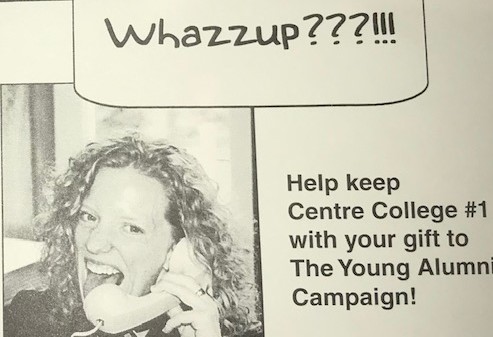
Whazzup? Advancement professionals in educational institutions and nonprofits, read closely.
It was 1999. My job was to increase young alumni giving at my alma mater: new president, cynical young alumni with no money, pursuing advanced degrees or newly employed, and paying off loans.
I formed the young alumni advisory committee. Members advised me to contact fellow young alumni with nothing institutional, slick, or serious. Giving was not a lost cause, but traditional appeals were off-putting.
I agreed. After all, I was one of them. But I also was a donor.
My boss allowed me to follow their advice. Cheap stock, one color, no logo, no outside approvals. The new president and a popular professor were on board to join me as faces for the Whazzup mailing, modeled off of a popular TV ad.
Young alumni percentage climbed from 29 to 52 percent that year. Similar pieces followed. No story. Just fun. Nontraditional. It worked. For us.
“But Jessica, that was annual giving. How does this apply to me?”
In my career, I have experienced this scenario across the board: from educational institutions to nonprofits, key decision makers to gift officers, new employees to student workers and interns, staff to faculty or researchers.
My takeaway: make no assumptions.
- Age doesn’t always matter. Do you assume people want to communicate by email, then they don’t reply? Pick up the phone. Text. Mail a personal note. Drop in with a “sorry I missed you” card and token gift. Send a social media message. Maybe a combination. Older folks may want an email and younger, a phone call.
- Stage matters. Are they in their 40s? They may be empty nesters. New parents. Single. Single again. Newly married. Married in college. No children. None by choice. Caring for parents. Struggling with life changes or as happy as they’ve ever been. Do you give them the same info? No.
- Prospect type matters. Approaching a corporation or foundation? Do your homework. Find a personal connection to open doors or advise you. Remember organizational interests may not match their type. And it all can change.
- Your background matters. Are you an alumna or alumnus? If you aren’t, don’t try to make your place of employment like your own institution. Do you have personal connections to the nonprofit? Find common ground.
- History matters. Any big changes in your organization? Expanded mission? New exhibitions? Programs added or removed? Two-year to four-year? Single-sex to co-ed? Tread lightly. Listen, don’t defend.
- Popular trends may not matter. Stay updated. But remember tips, trends, research, and stats may not apply to you.
- Stories matter. Particularly the person or organizations’ stories. That explains itself.
Make no assumptions.
I’ve experienced each of these bullets and can provide a fresh look at your programs. Contact me. I’d love to listen to your needs and interests and build a strategy. Allow me to use my record of success to work alongside you. Call, email, text, message, or comment. I’ll respond.
